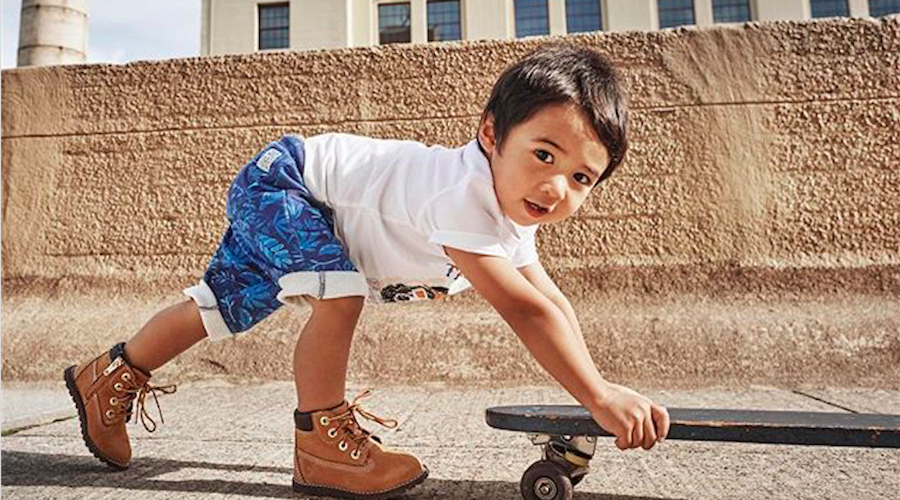Timberland plans to aggressively push further into women’s footwear, casual footwear overall and men’s apparel to jumpstart growth in the years ahead. Other key growth priorities included direct-to-consumer and China.
On overall diversification, Timberland will look to “accelerate growth beyond the boot,” said Jim Pisani, global brand president, Timberland, last week at VF’s Investor Day meeting.
He noted that in North America, classics, such its iconic yellow boot, makes up 40 percent of sales versus 60 percent for non-classic. International has a much better balance with only 16 percent of its sales mix representing classics. Said Pisani, “North America is too heavily reliant on our classic boots and the derivatives of the boot. And so this is an opportunity for us to really develop a more sustainable model.”
The push to grow non-classic offerings is expected to be helped in the years ahead by continuing its limited-release programs as well as elevating seeding to influencers. The “single biggest way” to diversify for Timberland, however, will be its platforms, including the SensorFlex comfort system, the AeroCore energy system and Classics Reimagined.
SensorFlex, launched in 2014, will reach over 3.5 million pairs in 2017. AeroCore is just rolling out this spring with 500,000 pairs to start and “initial sell-in and sell-through is really strong,” said Pisani, who took over Timberland seven months ago after running VF’s sports licensing business.
Women’s footwear doubled in North America for Timberland in the past few years with greater focus, but remains a largely untapped opportunity globally. More feminine styles and women shop-in-shops will continue to receive greater emphasis. Timberland is also working with an Italian design company to roll out a women’s line in Europe, and will leverage any lessons learned to other regions. Said Pisani, “We have a small percentage of this growing category and we’re going to obviously take care of it.”
Men’s apparel is “a robust and growing market for us” and is expected to benefit by moving its design team from London to Stabio in Switzerland to leverage insights from the apparel teams of Napapijri, North Face and Vans. Stated Pisani, “We’re going to leverage that apparel expertise like never before and combine that with our Timberland team and we think that’s a winning formula moving forward.”
The second growth area, direct-to-consumer, relates to bringing exclusive products, head-to-to collections and other “surprise and delight” experiences to its target outdoor lifestyle consumer at retail. Said Pisani, “Things like boot personalization, special events, getting your shoes refinished while you shop, having a cup of coffee while you’re along that what we call the Modern Trail.”
Dedicated-women’s spaces will also continue. Digital, which has been seeing strong double-digit growth across all regions in the last several years, will drive the largest percent of Timberland’s growth over the next five years. A focus will be on meeting its target customer through mobile, boosted by a plan to partner with over 200 digital influencers and bloggers.
The final growth driver is expected to be China, where Timberland conducts only about 3 percent of its global revenue. The market is seen as having a $200 billion opportunity by 2021. By comparison, Vans and North Face is closer to 7 percent to 8 percent of their overall revenue in China.
“They’ve built a great model, specially Vans for us to follow and we’re going to adopt that model and continue to grow,” said Pisani.
Priorities to gain a stronger foothold in China include working with franchise partnership stores and “rapidly” expanding its DTC presence with its Footwear Plus model. On the product front, the focus will be complementing its in-line collections with local-driven capsules such as a recent one well received around Chinese New Year. Local marketing campaigns will also receive investments.
Target-wise, Timberland’s focus is on the “outdoor lifestyler,” a “more urban” and “more casual” outdoor consumer that sees “style is critical.” Overall, VF sees the outdoor lifestyle market reaching 28 percent of the overall footwear and apparel. Said Pisani, “Our vision is to be the largest, most sustainable outdoor lifestyle brand on earth.”
Globally, Timberland’s sales are expected to grow at a compound annual growth rate (CAGR) of 4 to 6 percent over the five-year period from 2016 to 2021.
By channel, sales for Timberland are expected to grow over the next 5 years at a CAGR of 2 to 4 percent at wholesale, 3 to 5 percent at DTC (stores), and 23 to 35 percent at DTC (digital). By category, Men’s is expected to grow at a CAGR from 2016 to 2021 of 3 to 5 percent; Women’s, 6 to 8 percent; and Apparel & Other, 6 to 8 percent.
In 2016, the U.S. accounted for 42 percent of Timberland’s sales, followed by EMEA, 37 percent; APAC, 16 percent; and non-U.S. Americas, 5 percent. Wholesale made up 69 percent of sales versus 26 percent for DTC (stores), and 5 percent for DTC (digital). Men’s made up 57 percent of sales versus only 15 percent for Women’s and 28 percent for Apparel & Other.
Photo courtesy Timberland
















